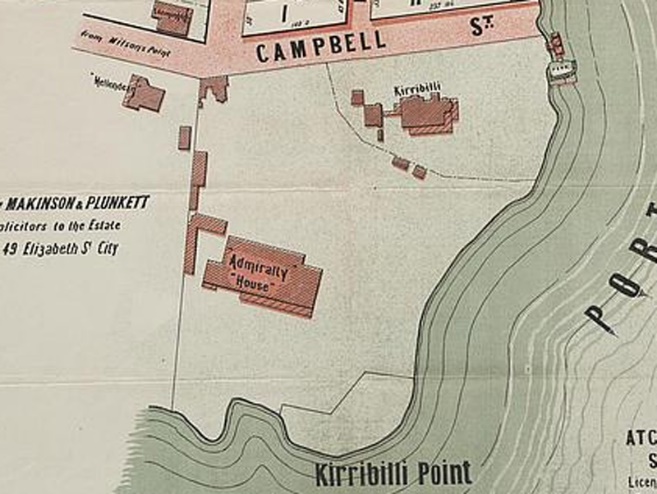Admiralty House, set in a garden and with its historic waterside fortification, is located on Sydney’s harbour opposite the Opera House in the suburb of Kirribilli. Its heritage listing is based on its association with a succession of prominent Colonial administrators and businessmen, it having been the Official Residence for Royal Naval Commanders and being the Sydney residence of Australian Governors General. The sandstone house is one of Sydney’s finest quality mansions set in one of the most desirable locations. Its Georgian style has been maintained despite successive modernisations.

The residence has two storeys with a slate hipped-gable roof and verandas providing harbour views around each storey. There is a colonnade of stone semi-circular arches to the ground floor veranda and elaborate cast-iron balustrades to the upper. Double French Doors with full-length shutters open onto each veranda and behind them the interior is elegantly decorated with fine furnishings that include items have been sought and acquired by The Australiana Fund. The house has fine Gatehouse gates and gardens, a boat landing and a former fortification and Marine Barracks that now house a swimming pool with facilities.
Early history
Six years after the First Fleet arrived in Port Jackson in 1788 the land on the northern shore of the harbour was granted to an expired convict, Samuel Lightfoot. That land then had various owners, including political prisoner Thomas Muir and Robert Ryan. By 1801 the property had passed into the hands of Robert Campbell who leased most of it for grazing. In 1842 Campbell leased two acres of his property to the Colonial Collector of Customs, Lieutenant Colonel John George Nathaniel Gibbes[i]. Gibbes proceeded to design and build the substance of Admiralty House as it now is, a single-storey stone residence. On Campbell’s death Gibbes bought the property for about £1400. Just two years later it was sold for the first in a number of times, gaining the name Wotonga.

In the early 1850s the land was used by the government as a defence point during the Crimean War. Harbour foreshore fortifications were constructed between 1857 and 1859 and form, including a battery (the only existing battery of this type and period in Australia) gunners’ store, powder magazine and Marine Barracks. Norfolk pines were also planted around the garden. The fortifications were built.

In 1885 the property became the residence of the Admiral of the British Royal Navy’s Australian Squadron and remained so until 1913. Accordingly, its name was changed to Admiralty House. New servants’ quarters, offices and passages were added together with a second storey and stone colonnades, all of which remain today.
Following a decision by the Commonwealth Government to establish an Australian Fleet it was agreed in 1909 that the British Imperial Government would relinquish all its Sydney properties used for Naval purposes. In 1913, despite objections from the NSW Government, the Commonwealth Government assumed control of Admiralty House as a residence for the Governor-General when in Sydney. Seven years later, in 1920, the Commonwealth Government bought the adjacent Kirribilli House (now the Australian Prime Minister’s Sydney residence) and until 1930 it was used as an adjunct to Admiralty House, providing additional accommodation for the Governor-General’s staff.

In 1931, at the height of The Great Depression, Admiralty House was temporarily closed and all its contents sold at public auction. It was reopened five years later. In 1948 formal title to the property was finally passed to the Commonwealth by Crown grant, on condition that it only be used as a residence for the Governor-General.

In June 2004 Admiralty House was included into the Commonwealth Heritage List, as Commonwealth owned or controlled places with significant heritage.

Video Tour
References:
A brief history of Admiralty House, Sydney, Governor General’s website Mar 2014
Admiralty House, NSW Office of Environment and Heritage
Fact Sheet: Admiralty House, Gardening Australia
Admiralty House, The Australiana Fund
[i] The Campbell and Gibbes families are also linked with Government House in Canberra. On his retirement in 1859, Colonel and Mrs Gibbes went to live with their son Augustus who owned “Yarralumla Station”. That property was later sold to Frederick Campbell, the grandson of Robert Campbell. Frederick built the residence “Yarralumla” which today is Government House.



